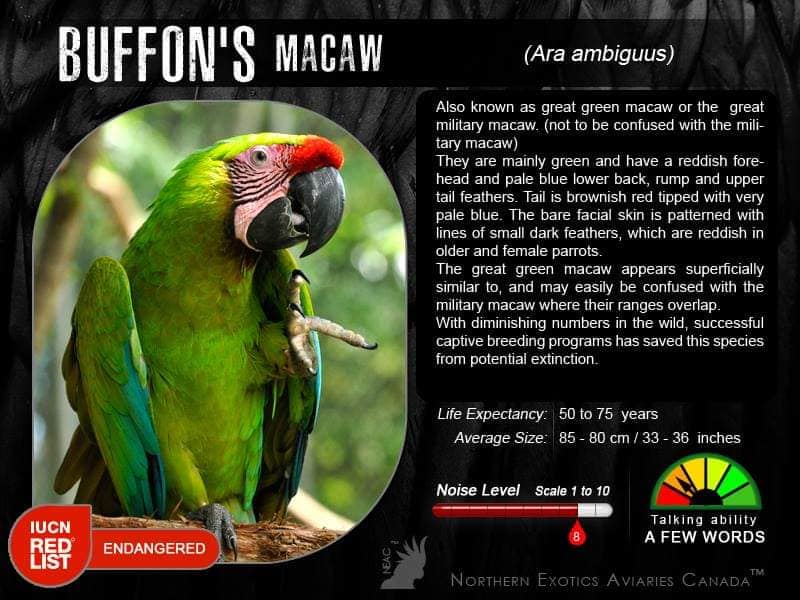Buffon's Macaw - Ara Ambiguus - Endangered
The great green macaw (Ara Ambiguus), also known as Buffon's macaw or the great military macaw, is a Central and South American parrot found in Nicaragua, Honduras, Costa Rica, Panama, Colombia and Ecuador. This species lives in the canopy of wet tropical forests and is highly dependent on the almendro tree. Two allopatric subspecies are recognized; the nominate subspecies (Ara ambiguus ambiguus) occurs from Honduras to West Colombia, while Ara ambiguus guayaquilensis is isolated on the Pacific side of the continent in Ecuador, and possibly South-Western Colombia. Buffon's Macaws are intelligent and social birds that can live up to 60 years in captivity.
Description
Great green macaws are the largest parrots in their natural range, the second heaviest macaw species (although are relatively shorter tailed than other large macaws such as the red-and-green macaw and are thus somewhat shorter), and the third heaviest parrot species in the world. This species averages 85–90 cm (33.5–35.5 in) in length and 1.3 kg (2.9 lb) in weight. They are mainly green and have a reddish forehead and pale blue lower back, rump and upper tail feathers. Tail is brownish red tipped with very pale blue. The bare facial skin is patterned with lines of small dark feathers, which are reddish in older and female parrots.
The great green macaw appears superficially similar to, and may easily be confused with the military macaw where their ranges overlap.
Distribution and Habitat
The great green macaw lives in tropical forests in the Atlantic wet lowlands of Central and South America from Honduras to Western Ecuador. It is usually observed below 600 m, but can be seen as high as 1500 m above sea level at some times of the year. In Costa Rica, the range of the great green macaw is restricted to 1120 km2 of very wet forests along the border with Nicaragua where there are populations in the Bosawas and San Juan reserves, which represents only 10% of its historical range. Although it is now rare near the Rìo Platano in Honduras, it still occurs there. In Panama, it can be observed on the Caribbean slope, near Cana and Alturas de Nique, and the adjacent Colombia.
Before 1994, very few things were known about the natural history of the great green macaws and their abundance was in a sharp decline. In order to improve our knowledge on the ecology and natural history of this bird, a large radio telemetry was conducted by a team of researchers between 1994 and 2006. The main objectives of this study were to determine the home range of A. ambiguus, characterize the habitats that it frequents and learn more about its natural history in general (feeding habits, ecological associations, abundance, and reproduction and nesting habits). The results of this study were published in 2007. It was found that, in Costa Rica and adjacent Panama, the habitats where great green macaws occur were dominated by the wood almond trees and raffia palms. This is not surprising considering that great green macaws depend on palms for both feeding and nesting.
Another study published in 2007 revealed that the abundance of food within a habitat is not related to the abundance of macaw; however the researchers found that there was a link between the abundance of food and the amount of time great green macaws spend at one place.
Behaviour
Diet
The Buffon's macaw is known to feed on 37 species of trees, including the wood almendro (Dipteryx panamensis), Sacoglottis trichogyna, Vochysia ferruginea and monkey pot (Lecythis ampla), which composes most of its dietary source of food. In fact, they rely so much on this tree that the seasonal movements of A. ambiguus follow the asynchronous ripening of D. panamensis fruits. In Ecuador, two Buffon's macaw were observed eating orchids, which composed 71% of their diet.
Reproduction
The great green macaw's breeding season starts in December and ends in April, but the time and duration vary depending on the location. Before building a nest, a pair establishes a large territory that does not overlap with that of other couples, and then, they find a tree cavity in which they can build a nest. Dipteryx panamensis is the nesting substrate 90% of the time. The female lays 2-3 eggs and incubates them for about a month period. This species has high reproductive success (60% of young survive), which is not surprising given its relatively small clutch size.
Vocalisation
A loud "aak, raak" that can be heard at great distances.
Conservation Status
This species of parrot is still endangered all over its range even though the numbers seem encouraging. In 1994, the population of Costa Rica was estimated at 210 individuals with only 35 to 40 breeding pairs. Following conservation efforts, the population of macaws in Costa Rica was estimated at 1530 individuals. In Colombia, they seemed to do relatively well in 2005 as the population was estimated at a total of less than 2500 individuals (or 1700 adults). The total population of Ecuador was estimated between 60 and 90 individuals in 2002, and reports from 2012 indicates that there are probably only 30 to 40 individuals left.
The global population estimation has recently been revised to 3500 by the American Bird Conservancy.

Psittaciformes, The Parrot Index, a part of Phoenix Feathers © 2016 - 2024
Page last updated: 1/4/24
Phoenix Feathers

